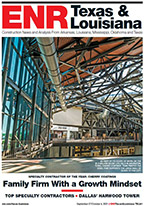Structural coordination was also necessary, especially below grade. Developing a frame for 4 WTC that would meet all of the stakeholders' needs was difficult, says Richard Garlock, project manager for the local Leslie E. Robertson Associates (LERA), 4 WTC's structural engineer. There has been “a long vetting process” given the number of stakeholders, he says.
“The biggest challenge on the structural construction side was to develop, as opposed to conceive, a structural system that would respond to the various needs of everyone,” says William J. Faschan, a LERA partner. To that end, LERA worked side by side with Tishman to determine how best to assemble and adjust the steel-first construction while making way for the reinforced concrete frame that follows the steel up the building.
That resulted in a hybrid frame, with perimeter steel columns encased in concrete and a reinforced concrete core. For example, LERA had to specify openings in the metal decking for the formwork and reinforcing steel for the concrete elements that followed 10 floors below, Faschan says.
Highs and Lows
Construction below grade presented its own issues. The tower is founded on bedrock 85 ft below grade. Before work commenced, there were “quite erratic” elevations with a large depression of rock surface in the middle, Garlock says. Instead of being filled with rock, the depression had been filled with cobblestones and rounded stones that were not capable of supporting the tower and needed to be excavated. “So the contours of what crews would be founding on was not [immediately] known because about one-third of the site was still being excavated as [foundation] work was proceeding,” he says. The solution was to fill the depression with lean concrete fill to replicate the rock needed.
Because it is coming up ahead of 2 and 3 WTC, 4 WTC is serving as a rehearsal of sorts for 3 WTC. Early on when construction began on 4 WTC, Tishman did not have all of the stakeholder work to coordinate. The result was that builders were left in what Goldberg calls “catch-up mode” for a while.
At this point, however, those issues are in the past for Tishman, Goldberg says. “We're focusing on tower three, so lessons learned on tower four will be applied there,” he says. Both he and Faschan have a long history with the WTC site and describe their experiences with this project as moving, given the larger context of the rebuilding effort. For Faschan, working on the tower that sometimes misses the spotlight for being in the figurative shadows of 1 WTC has been a highly “satisfying” experience, he says.
“The building is somewhat refined and restrained because of its context” across from the 9/11 memorial and museum, Faschan says. “Not all buildings are going to be the ones that are necessarily going to be the focus,” he says. “But this is part of the ensemble and a very special building certainly for those of us who have been involved.”







Post a comment to this article
Report Abusive Comment